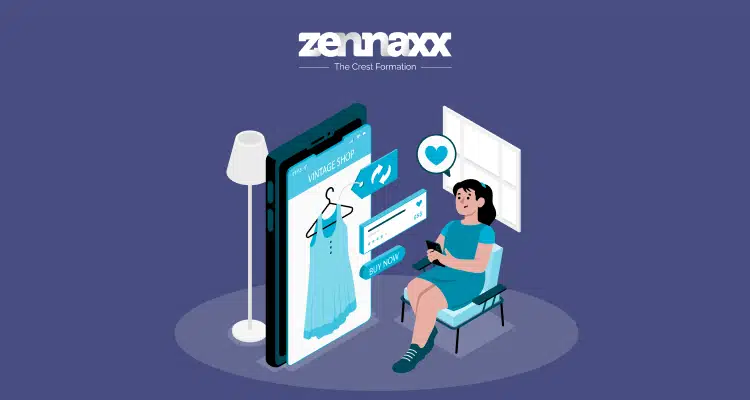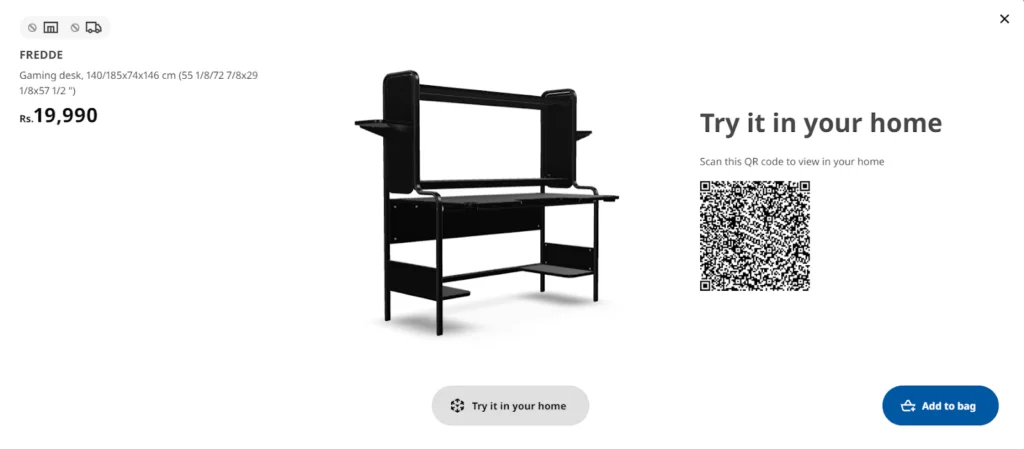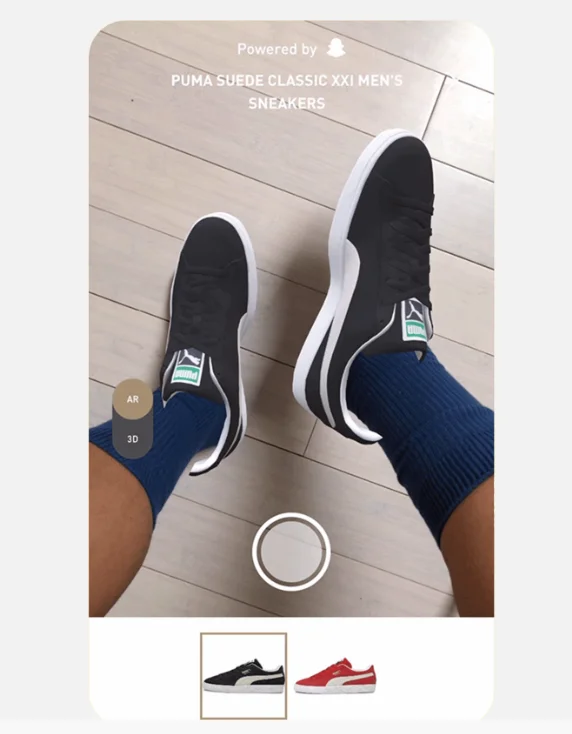What is the reason why your customers buy unique pairs of clothes and return them the next day?
A customer purchases a beautiful sofa for their home and returns it with feedback that it’s big for their home.
One problem with eCommerce for a long time has been that customers do not need help to touch and get the exact feel of the products before buying them.
But augmented reality (AR) is changing this, making shopping online and in stores feel more like one experience.
With augmented reality, your customer can see how that couch will look in their living room or how that dress will fit without leaving the house.
After the eCommerce market became tough, AR brought a new revolution in online shopping.
AR is now an important part of eCommerce because it provides new experiences in online shopping.
Explore our in-depth guide to learn how AR is changing the way we shop online and will affect eCommerce in the future.

Global Consumer Report: Current and Future Shopping Trends
With a 77% annual growth rate from 2019 to 2023, the augmented reality (AR) market is changing how people shop online.
Increasing Consumer Engagement
Over 32% of shoppers are currently using AR, which shows how well it interacts with customers.
AR methods clearly have a big effect on customer interest because they get 200% more engagement than traditional methods.
A Lasting Change
Using AR online shopping isn’t just a trend; it’s a big change. It raises shoppers’ expectations and creates new opportunities for retailers because it makes shopping more immersive and personalized.
Boosting Retailer Success
AR can help retailers improve their Conversion Rate Optimization (CRO).
Augmented reality (AR) makes shopping more fun, which gets more people to complete their purchases and increases sales.
The Future of Augmented Reality in eCommerce
AR will soon be an important part of online shopping, changing the way online stores work.
If stores use AR, they’ll be able to meet changing customer needs and make shopping more enjoyable.
Augmented Reality in Ecommerce Statistics
Consumer Adoption on the Rise: As of 2024, over 32% of consumers leverage AR while shopping online. This indicates a continued rise from previous years in augmented reality in ecommerce.
Expanding User Base: Estimates project there will be a staggering 1.73 billion global AR users on mobile devices by the end of 2024, reflecting significant growth in the technology’s accessibility.
Boosting Engagement: AR experiences demonstrably outperform traditional methods. They captivate users with 200% more engagement compared to non-AR alternatives.
Retailer Preference for AR: A significant 61% of retailers prioritize offering customers an Augmented Reality ecommerce experience, recognizing its value in enhancing the online shopping journey.
Demand for AR Integration: The desire for AR is clear – 71% of eCommerce buyers are willing to shop more frequently if AR technology becomes more widely available.
What is Augmented Reality?
Augmented reality (AR) is a technology that puts digital content into an authentic user experience.
AR improves the user’s experience by combining computer-generated visuals, sounds, text, and graphics with their surroundings.
Examples of AR in Life
- Visual Search: AR lets you search by pointing your mobile camera at real-life objects.
- Google Maps Live View: Helps users visualize destinations with real-world overlays.
- Gaming and Social Media: Apps like Pokémon Go and Snapchat filters are popular AR applications.
AR is used in many fields to improve marketing and operations. Online and offline retailers heavily invest in AR to develop distinctive brand experiences.
This technology is quickly becoming an important tool for better customer engagement and sales.
How is Augmented Reality Different From Virtual Reality?
When people talk about technology, they often use the terms “augmented reality” and “virtual reality” to mean the same thing, but they are actually different terms.
Augmented reality adds to the world that you can still see and experience in some way.
Virtual reality is a completely immersive experience that puts you in a world that people made. The real world is sometimes hidden from you and is not meant to be experienced.
For virtual reality, you may need to hold controllers and wear a headset. It would help if you also made sure that the place where you live is safe.
However, for AR, you usually only need a smartphone or, in some cases, AR glasses. You won’t have to clear the room to enjoy the experience because you’ll know everything around you.
Types of AR Applications
Different augmented reality (AR) technology types each have their own special features. The most common types of AR apps are broken down below:
- Marker-based AR: This form of augmented reality (AR) takes its cues from a predetermined item (the “marker”) placed in front of the camera to activate various forms of amusement. When the AR device finds the marker, it replaces it on the screen with a 3D version of the object that goes with it. The user can see and interact with the object more clearly from various angles.
- Markerless AR: Markerless AR doesn’t need a specific object to turn on content like marker-based AR does. You can place virtual objects wherever you want and interact with them by rotating and moving them.
- Location-based AR: Geographic location data is used to show digital content in certain places with this type of markerless AR. Pokémon Go is a popular example of a game that overlays digital creatures in real locations.
- Projection-based AR is augmented reality that uses projections, puts fake light on real surfaces, and sometimes lets users interact with it. Examples of projection-based AR include the holograms in sci-fi movies like Avatar and Marvel movies.

How Ecommerce Businesses Are Using Augmented Reality
Augmented reality in ecommerce connects customers to the product so that they can feel the product overview.
Customers can see how products fit into their daily activities with AR, satisfying them.
1. Virtual Try-On Solutions
Sometimes, customers see a product online, take it without any matching tone, and return it.
This common frustration can lower conversion rates because consumers still determine if the product matches their online mindset.
Customers can try on clothes, accessories, makeup, and even eyeglasses virtually before they buy them. This helps them decide if they like how something looks on them.
2. Preview Placement
Preview placement with AR solves this problem by allowing people to see how a product will look in their space right now.
For instance, customers can use their iPhones and iPads to view accurate 3D models of their couches in their living rooms by downloading the Burrow at Home app from the DTC furniture brand Burrow.
3. Interactive User Manuals
If your product is hard to learn, an interactive AR user guide could be just what you need. Users can get on-page, context-based help from these manuals to learn how to use your product.
Many AR user guides scan the item and use animated arrows and pictures to show you which buttons to press and how to use them.
4. Social media filters
These AR filters on Instagram and Snapchat aren’t just for fun anymore; they’re also very useful for businesses.
Using these filters, users can virtually try out new products, which increases engagement and gets them to tag your brand in their content.
Augmented reality filters can help your brand stand out on social media and show what makes you special. People are also considering AR in new software product ideas and love it in all types of social media apps.
Ready to Transform Your E-commerce Experience with Augmented Reality?
Have questions or ready to take the next step? Reach out to us today and let’s innovate together.
The Benefits of Augmented Reality in Online Shopping
Augmented reality (AR) is changing the online shopping experience with the latest technology.
Your customer can get closer to your product and make the right decision with different shapes and colours. Here are the key benefits AR brings to online shopping:
1. Enhanced Conversion and Sales
Augmented reality (AR) can greatly boost online sales by giving customers a more accurate perception of goods.
This strategy will make your business more trustworthy and increase your productivity. Studies show that augmented reality users are 30% more likely to buy something.
An additional study by Harvard Business Review discovered that AR can boost conversion rates by 20% by lowering hesitation at the checkout stage.
2. Reduced Product Return Rates
Augmented reality in ecommerce helps reduce product rejections by letting customers see items clearly and accurately before buying them.
This makes customers more likely to be happy with what they buy.
Customers can see how items will look in their space with AR, which helps them ensure the item fits well and meets their needs. This cuts down on returns because of problems with size.
3. Personalized Shopping Experience
Augmented reality makes shopping very personalized for your customer base.
Customers can try on clothes, accessories, or makeup virtually to see how they look before buying. They can also visualize how furniture or decor will fit in their home.
This interactive experience increases customer interest and satisfaction. AR can also suggest items based on what you’ve bought before, which makes shopping more personalized to customer tastes.
4. Elimination of Physical Space Requirements
AR will also reduce the need for physical stores in the future by providing an immersive online shopping experience.
With a virtual showroom, customers can look at products realistically from anywhere. They can make purchases from home and still feel the product as if they were in a store.
It removes the limitations of physical distance and provides a time-saving experience for the customers.
5. Competitive Advantage
Using AR can help your business stand out from others in the same field.
Due to the low number of retailers using AR right now, implementing this technology can help your company stand out as innovative and customer-focused.
This will attract tech-savvy customers looking for the best online shopping experience because it shows that your brand is up-to-date and cares about what your customers want.
It’s easy to see how AR can help eCommerce. It is important to determine how much it will cost and what you need to do to make an AR app for your online store.
Contact Zennaxx to inquire about the cost of developing an AR app in 2024.
How to Bring Augmented Reality to Your Ecommerce Store
Now, you want to know the basic steps for integrating AR into your eCommerce business. Here, we give you a checklist to check these steps before implementing AR in your store.
1. Clarify your business objectives
First, you need to understand your goals. Make them clear: What do you want to achieve with augmented reality, and how will it benefit your customers?
- Business Goals: Everyone’s business goal is the same: to reduce product returns, increase sales, or improve customer engagement in-store.
- Customer Benefits: How will AR improve the shopping experience? Can it show customers how products would look in their space or allow them to try on items virtually?
Making a list of your objectives will help you choose the appropriate AR technology and ensure that it benefits your clients.
2. Choose the Right Augmented Reality Tools
You can choose the right AR tools once you know your goal. Consider these factors:
- License Type: If you’re on a budget, look for AR platforms that offer free licenses. Remember that free versions may have fewer features than paid ones.
- Supported Devices: Decide which devices (like mobile phones, tablets, or AR glasses) your AR app will help. Make sure the tool you select is compatible with these devices.
- Supported Operating Systems: If you want your app to work on multiple operating systems (iOS, Android, etc.), check that your chosen platform supports them.
- Capabilities: Consider each platform’s capabilities. If you require location-based features, make sure the platform supports Geo-location services.
3. Market Your New Tool
When your augmented reality app is complete, you must inform your customers about it. Here are some ways you can spread the word:
- Create a Demo Video: Make engaging videos that show how to use your AR app. Share these on your website, social media, and other marketing platforms.
- In-App Instructions: If you want people to understand how to use the AR features, ensure the app has a clear guide with easy-to-follow instructions.
- Shareable Content: Encourage users to share their AR experiences on social media by making them funny or interesting. This can increase visibility and attract more customers from other platforms.
This basic instruction will upgrade your store’s visibility and functionality for your customers.
Let’s look at some popular brands, how they introduce augmented reality in manufacturing, and what impact they create in business.
Want to Automate Your Business Process With a Software Solution?
Zennaxx, a leading software development firm in Canada, has delivered 700+ bespoke solutions spanning various industries.
Case Studies of Augmented Reality in the eCommerce Sector
- Do you still need clarification about implementing augmented reality in ecommerce stores?
Some popular brands say they use these technologies in business and get benefits. Let’s see how these features greatly impact your eCommerce store.
Case Study 1: IKEA Place App
The IKEA Place app has been a popular home furniture selling platform since early 2017 and is still the first choice of people.
The IKEA Place app provides the AR facility to check the furniture at the customer’s home easily. Before buying something, this cool tool lets people see how it will look and fit in their space.

Since its release in 2017, the app has become very famous, and by August 2022, it had over 4.9 million users.
It has had a big impact on IKEA’s business. Product returns are down by over 30%. With this drop in returns, the company saves time and money, and employees work faster and better.
The app makes shopping more enjoyable and makes customers happier by helping them make better decisions about what to buy.
Case Study 2: Snapchat and Puma’s Collaboration
Snapchat and Puma collaborate by sharing exclusive brand content and promotions with their followers.
Through this partnership, Puma wants to get the word out about its tracksuits and suede shoes in a new and interesting way.

Snap’s data shows that about 250 million users have used this augmented reality feature.
This significant level of engagement demonstrates how AR has the potential to alter how people shop for clothes online.
This feature elevates the shopping experience and boosts brand engagement and sales by letting users virtually try on clothes.
According to these case studies, augmented reality (AR) technology is changing the eCommerce business in useful ways for customers and companies.
Wrapping Up
Technology’s use in visualization and representation of data has become increasingly popular in recent years.
The need for businesses to understand large amounts of complex information in a more palatable format is driving this trend.
Apple has also released Vision Pro, which makes it easy for users to create and customize data visualizations. So why are we not thinking about upgrading our eCommerce business with these new technologies?
Figuring out the different kinds of augmented reality, their uses, and their benefits can help you decide if it’s the best option for your business.
The augmented reality app development company Zennaxx has made cutting-edge AR solutions for small businesses, startups, and unicorns for almost ten years.
Contact us to discuss your business ideas and get personalized consultation for AR integration in your eCommerce business.


